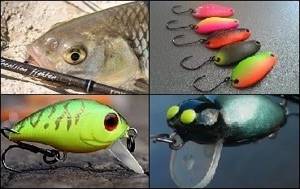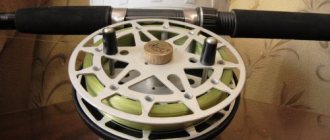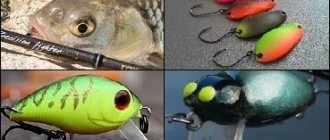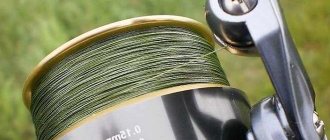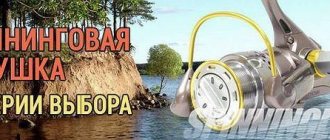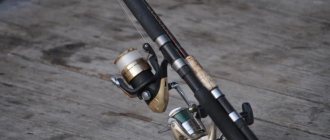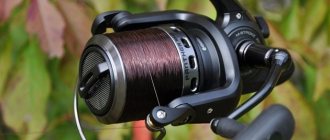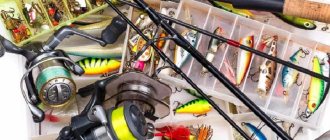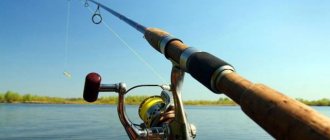Inertia-free, inertial or multiplier?
We can safely say that inertial reels in spinning equipment are a thing of the past. They are not very convenient because they continue to rotate until you stop it. It can be used for rare casts, for example, in bottom gear. Inertia motors were used until inertialess motors appeared and at the moment they are used quite rarely.
When spinning reels , it became much easier for spinning anglers to use this type of gear. The manufacturer produces both lightweight models designed for using lighter baits, and powerful reels designed for catching large specimens.
Such reels are very easy to use and do not create any problems for the spinner.
Multiplier reels , or, as they are also called, marine reels, are designed for difficult fishing conditions. This is a fairly powerful type of reel, which is advisable to install on powerful fishing rods. They should be installed if the most powerful inertia-free one cannot cope with its task.
As a rule, baitcasting reels are the domain of professionals, but for a beginner, a spinning reel is what they need.
Types of spinning reels
The coils are:
- Inertial.
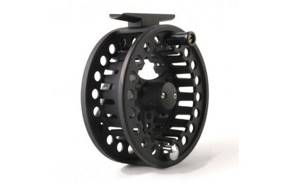
- Inertialess
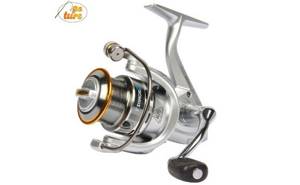
- Multiplier

Inertial coils are becoming increasingly rare these days. The good old “Nevskie” and the like remained in the hands of only the most conservative fishermen from the outback. Some people continue to actively fish for pike, perch, and taimen using it. I have long adapted my inertia only for grayling fishing.
A distinctive feature of the inertial action is its power, equal to your strength, and the continuation of rotation of the drum, if not stopped, even after the bait splashes down. This is what causes the appearance of frequent “beards”.
The peak of popularity of spinning reels, or “meat grinders,” will not pass soon. Very convenient and functional mechanisms that can satisfy the needs of any fastidious fisherman.
Multiplier reels are mechanisms, however, for connoisseurs. I’m unlikely to advise a beginner to start learning spinning by buying a multiplier. Plus, you will need to acquire a specialized fishing rod. The reels are powerful, like a winch, and can handle a variety of weights.
Inertia-free “meat grinders” are the optimal choice for mastering spinning fishing.
How to choose a spinning reel
The choice of coil is influenced by several parameters that you should pay attention to:
- Smooth running of the reel. The smoothness of the action determines the reliability of the bait and the quality of winding the fishing line onto the spool, which in turn affects the casting distance of the tackle.
- Spool size. This size is determined by fishing conditions, as well as the diameter of the fishing line. On each reel you can find the following numbers: 1000, 2000, 3000, etc. The number 1000 means that such a reel can hold 100 meters of fishing line with a diameter of 0.1 mm, 2000 - 200 meters of fishing line with a diameter of 0.1 mm, 3000 - 300 meters of fishing line with a diameter of 0.1 mm, etc. A lot depends on how far you plan to cast and what kind of fishing line you plan to use. In fact, on each reel there is a mark indicating how many meters and what thickness of fishing line can be placed on a given reel.
- Line handle. During casting, the line handler's bow folds back, and when the bait has reached its target, the bow closes, after which the fishing line stops reeling from the spool. It is very important that after closing, the fishing line falls exactly on the roller and cannot get caught anywhere.
- Friction clutch . This is a very important part of the reel, which allows you to absorb the jerks of large fish, which prevents the line from breaking. Reels can be equipped with either front or rear clutch. Higher quality reels are available with a front drag that has a finer setting.
- Reel weight. The weight of the reel only affects ease of use. At the same time, the weight of the reel depends on the quality of the material from which the reel is made. More powerful reels are made of stronger, but also heavier material. Therefore, we can safely say that a higher quality reel cannot be light.
- Handle design. Handles can have different fastenings:
- Fastening with screw.
- Screw-in handle.
- Rivet handle.
When choosing, you need to check how smoothly the handle locks. Very often, fine-threaded screws are used to secure handles. If, when rotating the screw, you feel a violation of the smoothness of the thread, it means that the thin handle has a hidden defect, which will very quickly manifest itself as thread breakage.
Number of bearings. As a rule, reels with at least 3 bearings are suitable for spinning tackle. The smooth running of the reel and its durability, as well as reliability, depend on the presence of bearings.
What is the difference between an inertial coil and an inertialess coil in principle?
Despite the centuries-old hobby of fishing, the reel became widely used only in the 19th century. The design was primitive: a drum with a line, equipped with a pair of small handles, was put on the axis of the body. When cast, the drum spun by inertia, hence the name.
Inertia-free systems appeared a century later and have not undergone significant changes to this day. The line comes off a stationary spool, rewinding is carried out by the line layer, which makes revolutions around it. This is briefly, if we consider inertial and inertialess coils, what is the difference.
It’s not difficult to get used to a modern meat grinder, so now the question doesn’t even arise as to which reel is better, an inertial or a non-inertial one. The advantages of the latter include a significant difference in the casting distance of the equipment and a lower risk of beard formation on the line.
What distinguishes spinning reels is the geometry of the spool, which we wrote about in the article “How to adjust a spinning reel while fishing,” and the high line laying properties. In inertial mode, the line has to be guided manually along the spool.
So, to summarize, what is the difference between a reliable inertia-free reel and an inertial one:
- Fishermen began to master the latter a century earlier.
- Inertial motors have a fairly simple design.
- They are much cheaper to purchase.
- The meat grinder is capable of very long casting.
- The likelihood of tangling the line is minimized.
Another question: how to choose inertialess fishing reels so that fishing not only becomes comfortable, but also provides a good catch. I think this topic was covered in the first part of our story.
How to choose a reel for a spinning rod
For rods with a length of 2.7-3.5 m, reels with a spool capacity of 2500 or more are suitable if fishing will be carried out from the shore and at short distances. To catch small specimens using ultralight baits, you can use 1500-2000 spools. If fishing does not have an exact definition of the size of fish specimens and when there is a possibility that a serious predator may bite on a light bait, then it is necessary to use a obviously powerful reel and not skimp on serious things.
Inductor. Inductance formula
The basic formula for coil inductance is:
- L = inductance in henry
- μ 0 = permeability of free space = 4π × 10 -7 H/m
- μ g = relative permeability of core material
- N = number of turns
- A = Cross-sectional area of the coil in square meters (m2)
- l = coil length in meters (m)
Direct conductor inductance:
- L = inductance in nH
- l = conductor length
- d = conductor diameter in the same units as l
Air core coil inductance:
- L = inductance in µH
- r = outer coil radius
- l = coil length
- N = number of turns
Inductance of multilayer air core coil:
- L = inductance in µH
- r = average coil radius
- l = coil length
- N = number of turns
- d = coil depth
Flat Coil Inductance:
- L = inductance in µH
- r = average coil radius
- N = number of turns
- d = coil depth
The best models of spinning reels
The fishing market is literally crammed with various models of spinning reels, produced by both well-known and little-known companies.
The best models.
- Shimano Exag e is not bad quality for little money.
- Shimano Catana is a branded model that is not cheap enough.
- Shimano Twin Power . A high quality reel, for which you will have to pay at least 12,000 rubles.
- Shimano Ultegra - available with different spool volumes, from 1000 to 6000. It has an average cost of about 5000 rubles.
- Shimano Nexave is a low-grade model, costing no more than 2,000 rubles.
- Shimano Biomaster is a middle-class reel with an average price of around 7,000 rubles.
- Shimano Nasci is a reel for beginners that costs no more than 3,800 rubles.
Widespread models of Daiwa spinning reels:
- Daiwa Reqal is inertia-free, costs 1,500 rubles and is intended for beginner fishermen.
- Daiwa Exceler is a powerful and reliable reel.
- Daiwa Crossfire is a low-class reel, costing no more than 2000 rubles.
- Daiwa Certate is a very high-class reel that costs at least 17,000 rubles.
Spinning reels from Ryobi.
This is a little-known company that produces spinning reels that are worthy of attention:
- Ryobi Excia is a widespread budget reel of good quality.
Inductor design
An inductor is a winding of conductive material, usually copper wire, wound around either an iron-containing core or no core at all.
The use of materials with high magnetic permeability, higher than air, as a core helps to retain the magnetic field near the coil, thereby increasing its inductance. Inductive coils come in different shapes and sizes.
Most are made by winding enameled copper wire over a ferrite core.
Some inductive coils have an adjustable core that allows the inductance to vary.
Miniature coils can be etched directly onto the PCB in a spiral pattern. Low-value inductors can be located in microcircuits using the same technological processes used to create transistors.
Choosing a fishing line for spinning
Depending on the fishing conditions, you can choose monofilament or braided fishing line. Each of them has its own advantages and disadvantages.
monofilament
- Much cheaper than braid.
- Ideal for short to medium distances.
- Capable of stretching.
- Not as strong as wicker.
Braided line (cord)
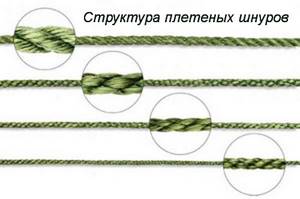
- A little more expensive than monofilament.
- Doesn't stretch.
- Ideal for long casts.
- Characterized by high strength.
Bobbin size
The size of the spool depends on the fishing method and the thickness of the fishing line. On reels you can find some values of 1000, 2000 or 5000. The number 1000 shows that the spool can hold 100 meters of fishing line with a thickness of 0.1 mm, and the number 3000 can hold one hundred meters of fishing line with a thickness of 0.3 mm.
- For light spinning (ultralight), reels with 1000-2500 spools are usually used.
- For medium spinning rod: 2500-3500.
- For heavy spinning, 4000+ spools are used.
- For feeder fishing, use reels with 2500-5000 spools.
- For carp fishing 5000+.
| |||
| Braid selection | Swimbait fishing | Types of inflatable boats | Chub fishing |
The size and depth of the spool should be selected depending on the length and diameter of the fishing line you are using and the casting distance of the bait.
